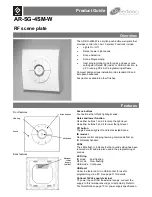I
2
C Interface
MCF52110 ColdFire® Integrated Microcontroller Reference Manual, Rev. 1
24-10
Freescale Semiconductor
Preliminary
24.3.4
Acknowledge
The transmitter releases the SDA line high during the acknowledge clock pulse as shown in
.
The receiver pulls down the SDA line during the acknowledge clock pulse so that it remains stable low
during the high period of the clock pulse.
If it does not acknowledge the master, the slave receiver must leave SDA high. The master can then
generate a STOP signal to abort data transfer or generate a START signal (repeated start, shown in
Section 24.3.6, “Repeated START”
) to start a new calling sequence.
Figure 24-9. Acknowledgement by Receiver
If the master receiver does not acknowledge the slave transmitter after a byte transmission, it means
end-of-data to the slave. The slave releases SDA for the master to generate a STOP or START signal
(
).
24.3.5
STOP Signal
The master can terminate communication by generating a STOP signal to free the bus. A STOP signal is
defined as a low-to-high transition of SDA while SCL is at logical high (see F in
). The master
can generate a STOP even if the slave has generated an acknowledgment, at which point the slave must
release the bus. The master may also generate a START signal following a calling address, without first
generating a STOP signal. Refer to
Section 24.3.6, “Repeated START.”
24.3.6
Repeated START
A repeated START signal is a START signal generated without first generating a STOP signal to terminate
the communication, as shown in
. The master uses a repeated START to communicate with
another slave or with the same slave in a different mode (transmit/receive mode) without releasing the bus.
5
6
7
8
9
4
3
2
1
Bit6
Bit4
Bit3
Bit2
Bit1
Bit5
Bit7
Bit0
START Signal
R/W
ACK
SCL
SDA by Transmitter
SDA by Receiver


















